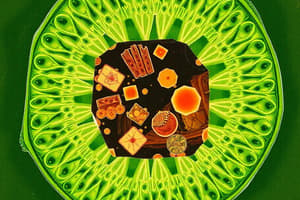Podcast
Questions and Answers
What is the function of the cell wall in plant cells?
What is the function of the cell wall in plant cells?
- Perform photosynthesis
- Control the passage of substances
- Contain chlorophyll
- Provide support and shape (correct)
Which organelle is responsible for photosynthesis?
Which organelle is responsible for photosynthesis?
- Ribosomes
- Mitochondria
- Chloroplasts (correct)
- Lysosomes
What is the function of cytoplasm in a cell?
What is the function of cytoplasm in a cell?
- Hold organelles and allow chemical reactions (correct)
- Control passage of substances
- Perform special functions
- Support and shape the cell
What is the function of the cell membrane?
What is the function of the cell membrane?
Which organelle traps radiant energy from the sun?
Which organelle traps radiant energy from the sun?
Where do chemical reactions and energy conversions occur in a cell?
Where do chemical reactions and energy conversions occur in a cell?
Match the following components with their descriptions:
Match the following components with their descriptions:
Match the following terms with their functions:
Match the following terms with their functions:
Match the following components with their specific roles:
Match the following components with their specific roles:
Match the following organelles with their characteristic features:
Match the following organelles with their characteristic features:
Match the following cellular components with their functions:
Match the following cellular components with their functions:
Match the following terms with their roles within a cell:
Match the following terms with their roles within a cell:
Flashcards are hidden until you start studying
Study Notes
Cell Wall
- Only found in plant cells, formed on the outside of the cell membrane
- Consists of a network of cellulose fibers
- Lends support and shape to the plant cell
Cytoplasm
- Consists of the ground plasm and the cell membrane
- Cell membrane is selectively permeable and controls the passage of substances into and out of the cell
Ground Plasm
- Liquid contents of the cell, consisting of various solutions
- Salts and gases are dissolved in the ground plasm
- Organelles, oil droplets, and protein granules are found in the ground plasm
- More liquid in the central part of the cell, making it easier for particles and organelles to float around
- More jelly-like near the cell membrane
- Site of chemical processes, including metabolism
Cell Organelles
- Chloroplasts are found only in plant cells and are responsible for photosynthesis
- Contain the green pigment chlorophyll, which traps radiant energy from the sun and converts it to chemical potential energy
- During photosynthesis, water and carbon dioxide are used to form glucose and oxygen is released
Studying That Suits You
Use AI to generate personalized quizzes and flashcards to suit your learning preferences.


